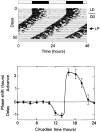Mammalian circadian biology: elucidating genome-wide levels of temporal organization
- PMID: 15485355
- PMCID: PMC3770722
- DOI: 10.1146/annurev.genom.5.061903.175925
Mammalian circadian biology: elucidating genome-wide levels of temporal organization
Abstract
During the past decade, the molecular mechanisms underlying the mammalian circadian clock have been defined. A core set of circadian clock genes common to most cells throughout the body code for proteins that feed back to regulate not only their own expression, but also that of clock output genes and pathways throughout the genome. The circadian system represents a complex multioscillatory temporal network in which an ensemble of coupled neurons comprising the principal circadian pacemaker in the suprachiasmatic nucleus of the hypothalamus is entrained to the daily light/dark cycle and subsequently transmits synchronizing signals to local circadian oscillators in peripheral tissues. Only recently has the importance of this system to the regulation of such fundamental biological processes as the cell cycle and metabolism become apparent. A convergence of data from microarray studies, quantitative trait locus analysis, and mutagenesis screens demonstrates the pervasiveness of circadian regulation in biological systems. The importance of maintaining the internal temporal homeostasis conferred by the circadian system is revealed by animal models in which mutations in genes coding for core components of the clock result in disease, including cancer and disturbances to the sleep/wake cycle.
Figures


Similar articles
-
Genetics of circadian rhythms in Mammalian model organisms.Adv Genet. 2011;74:175-230. doi: 10.1016/B978-0-12-387690-4.00006-4. Adv Genet. 2011. PMID: 21924978 Free PMC article. Review.
-
The sleep-wake distribution contributes to the peripheral rhythms in PERIOD-2.Elife. 2021 Dec 13;10:e69773. doi: 10.7554/eLife.69773. Elife. 2021. PMID: 34895464 Free PMC article.
-
Entrainment of circadian clocks in mammals by arousal and food.Essays Biochem. 2011 Jun 30;49(1):119-36. doi: 10.1042/bse0490119. Essays Biochem. 2011. PMID: 21819388
-
Circadian regulation of sleep in mammals: role of the suprachiasmatic nucleus.Brain Res Brain Res Rev. 2005 Nov;49(3):429-54. doi: 10.1016/j.brainresrev.2005.01.005. Brain Res Brain Res Rev. 2005. PMID: 16269313 Review.
-
Melatonin, Clock Genes, and Mammalian Reproduction: What Is the Link?Int J Mol Sci. 2021 Dec 8;22(24):13240. doi: 10.3390/ijms222413240. Int J Mol Sci. 2021. PMID: 34948038 Free PMC article. Review.
Cited by
-
Circadian timekeeping and output mechanisms in animals.Curr Opin Neurobiol. 2013 Oct;23(5):724-31. doi: 10.1016/j.conb.2013.02.018. Epub 2013 May 31. Curr Opin Neurobiol. 2013. PMID: 23731779 Free PMC article. Review.
-
Genetic association between PER3 genetic polymorphisms and cancer susceptibility: a meta-analysis.Medicine (Baltimore). 2015 Apr;94(13):e568. doi: 10.1097/MD.0000000000000568. Medicine (Baltimore). 2015. PMID: 25837749 Free PMC article.
-
Pathophysiology and pathogenesis of circadian rhythm sleep disorders.J Physiol Anthropol. 2012 Mar 13;31(1):7. doi: 10.1186/1880-6805-31-7. J Physiol Anthropol. 2012. PMID: 22738311 Free PMC article. Review.
-
MicroRNA-185 oscillation controls circadian amplitude of mouse Cryptochrome 1 via translational regulation.Mol Biol Cell. 2013 Jul;24(14):2248-55. doi: 10.1091/mbc.E12-12-0849. Epub 2013 May 22. Mol Biol Cell. 2013. PMID: 23699394 Free PMC article.
-
The endogenous molecular clock orchestrates the temporal separation of substrate metabolism in skeletal muscle.Skelet Muscle. 2015 May 16;5:17. doi: 10.1186/s13395-015-0039-5. eCollection 2015. Skelet Muscle. 2015. PMID: 26000164 Free PMC article.
References
-
- Abe H, Honma S, Honma K, Suzuki T, Ebihara S. Functional diversities of two activity components of circadian rhythm in genetical splitting mice (CS strain) J Comp Physiol [A] 1999;184:243–51. - PubMed
-
- Abrahamson EE, Moore RY. Suprachiasmatic nucleus in the mouse: retinal innervation, intrinsic organization and efferent projections. Brain Res. 2001;916:172–91. - PubMed
Publication types
MeSH terms
Grants and funding
LinkOut - more resources
Full Text Sources
Other Literature Sources
Miscellaneous

